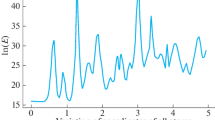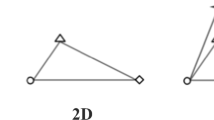Abstract
We report the application of a recently developed alignment-free 3D QSAR method [Crippen,G.M., J. Comput. Chem., 16 (1995) 486] to a benchmark-type problem. The test systeminvolves the binding of 31 steroid compounds to two kinds of human carrier protein. Themethod used not only allows for arbitrary binding modes, but also avoids the problems oftraditional least-squares techniques with regard to the implicit neglect of informative outlyingdata points. It is seen that models of considerable predictive power can be obtained even witha very vague binding site description. Underlining a systematic, but usually ignored, problemof the QSAR approach, there is not one unique type of model but, rather, an entire manifoldof distinctly different models that are all compatible with the experimental information. Fora given model, there is also a considerable variation in the found binding modes, illustratingthe problems that are inherent in the need for ’correct‘ molecular alignment in conventional3D QSAR methods.
Similar content being viewed by others
References
Stouch, T.R. and Jurs, P.C., J. Med. Chem., 29 (1986) 2125.
Kubinyi, H. (Ed.) 3D QSAR in Drug Design: Theory, Methods and Applications, ESCOM, Leiden, The Netherlands, 1993.
Cramer, R.D., Patterson, D.E. and Bunce, J.D., J. Am. Chem. Soc., 110 (1988) 5959.
Kellogg, G.E., Semus, S.F. and Abraham, D.J., J. Comput.-Aided Mol. Design, 5 (1991) 545.
Loughney, D.A. and Schwender, C.F., J. Comput.-Aided Mol. Design, 6 (1992) 569.
Good, A.C., So, S.-S. and Richards, W.G., J. Med. Chem., 36 (1993) 433.
Jain, A.N., Koile, K. and Chapman, D., J. Med. Chem., 37 (1994) 2315.
Norinder, U., J. Comput.-Aided Mol. Design, 4 (1990) 381.
Norinder, U., J. Comput.-Aided Mol. Design, 5 (1991) 419.
Carlstedt-Duke, J., Nilsson, L. and Norinder, U., In Kubinyi, H. (Ed.) 3D QSAR in Drug Design: Theory, Methods and Applications, ESCOM, Leiden, The Netherlands, 1993, pp. 373–385.
Crippen, G.M., J. Comput. Chem., 8 (1987) 943.
Bradley, M.P. and Crippen, G.M., J. Med. Chem., 36 (1993) 3171.
Srivastava, S. and Crippen, G.M., J. Med. Chem., 36 (1993) 3572.
Crippen, G.M., J. Comput. Chem., 16 (1995) 486.
Jain, A.N., Dietterich, T.G., Lathrop, R.H., Chapman, D., Critchlow Jr., R.E., Bauer, B.E., Webster, T.A. and Lozano-Perez, T., J. Comput.-Aided Mol. Design, 8 (1994) 635.
Hahn, M. and Rogers, D., J. Med. Chem., 38 (1995) 2091.
Jain, A.N., Harris, N.L. and Park, J.Y., J. Med. Chem., 38 (1995) 1295.
Mickelson, K.E., Forsthoefel, J. and Westphal, U., Biochemistry, 20 (1981) 6211.
Dunn, J.F., Nisula, B.C. and Rodbard, D., J. Clin. Endocrin. Metab., 53 (1981) 58.
Cerius2, Molecular Simulations Inc., Burlington, MA, U.S.A., 1994.
Allinger, N.L., J. Am. Chem. Soc., 99 (1977) 8127.
MM2(91), Allinger, N.L., University of Georgia, Athens, GA, U.S.A., 1991.
Lipkowitz, K.B., QCPE Bull., 12 (1992) 6.
DGEOM, Blaney, J.M., Crippen, G.M., Dearing, A. and Dixon, J.S., Copyright DuPont Corporation, 1990; QCPE Program 590, Indiana University, Bloomington, IN, U.S.A.
‘Padre’, Stahl, M. and Walters, P., University of Arizona, Tucson, AZ, U.S.A., 1995.
Smellie, A., Kahn, S.D. and Teig, S.L., J. Chem. Inf. Comput. Sci., 35 (1995) 285.
Gasteiger, J. and Marsili, M., Tetrahedron, 36 (1980) 3219.
Galaxy, Copyright Ghose, A.K., 1995; AM Technologies, San Antonio, TX, U.S.A.
Wold, S., Technometrics, 20 (1978) 397.
Press, W.H., Teukolsky, S.A., Vetterling, W.T. and Flannery, B.P., Numerical Recipes in C, 2nd ed., Cambridge University Press, Cambridge, U.K., 1992.
Author information
Authors and Affiliations
Rights and permissions
About this article
Cite this article
Schnitker, J., Gopalaswamy, R. & Crippen, G.M. Objective models for steroid binding sites of human globulins. J Comput Aided Mol Des 11, 93–110 (1997). https://doi.org/10.1023/A:1008031629127
Issue Date:
DOI: https://doi.org/10.1023/A:1008031629127




